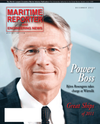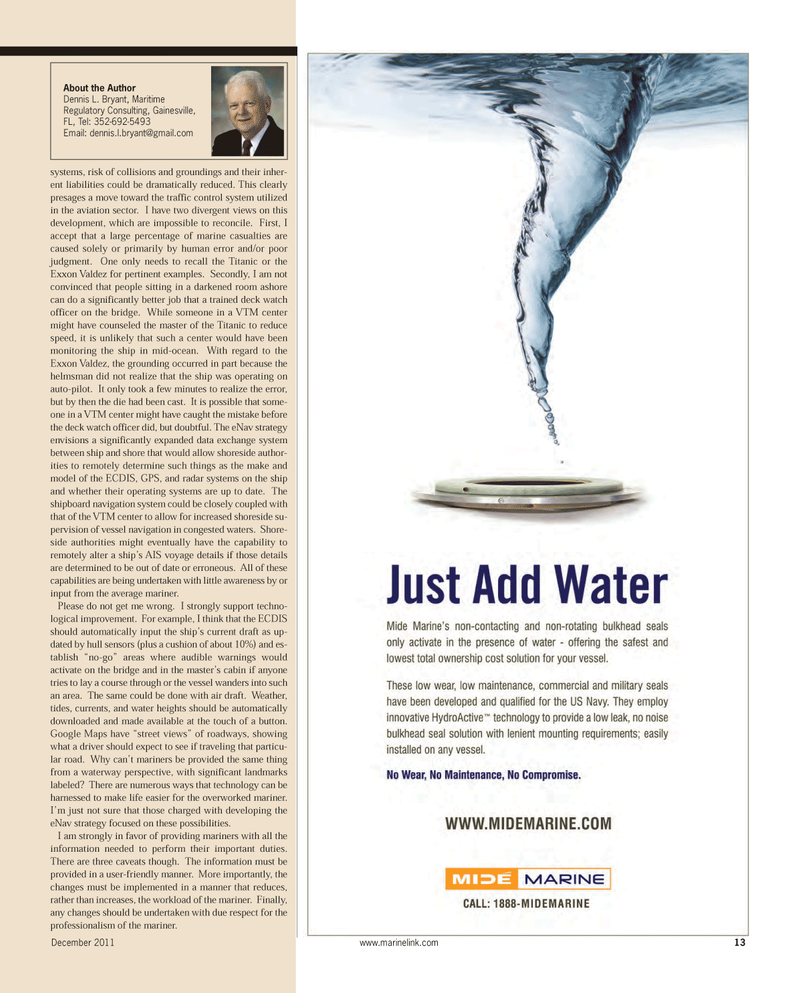
Page 13: of Maritime Reporter Magazine (December 2011)
Great Ships of 2011
Read this page in Pdf, Flash or Html5 edition of December 2011 Maritime Reporter Magazine
December 2011www.marinelink.com 13systems, risk of collisions and groundings and their inher- ent liabilities could be dramatically reduced. This clearly presages a move toward the traffic control system utilized in the aviation sector. I have two divergent views on this development, which are impossible to reconcile. First, I accept that a large percentage of marine casualties are caused solely or primarily by human error and/or poorjudgment. One only needs to recall the Titanic or the Exxon Valdez for pertinent examples. Secondly, I am not convinced that people sitting in a darkened room ashore can do a significantly better job that a trained deck watch officer on the bridge. While someone in a VTM center might have counseled the master of the Titanic to reduce speed, it is unlikely that such a center would have been monitoring the ship in mid-ocean. With regard to the Exxon Valdez, the grounding occurred in part because the helmsman did not realize that the ship was operating on auto-pilot. It only took a few minutes to realize the error, but by then the die had been cast. It is possible that some- one in a VTM center might have caught the mistake before the deck watch officer did, but doubtful. The eNav strategy envisions a significantly expanded data exchange system between ship and shore that would allow shoreside author- ities to remotely determine such things as the make and model of the ECDIS, GPS, and radar systems on the shipand whether their operating systems are up to date. The shipboard navigation system could be closely coupled with that of the VTM center to allow for increased shoreside su- pervision of vessel navigation in congested waters. Shore- side authorities might eventually have the capability to remotely alter a ship?s AIS voyage details if those details are determined to be out of date or erroneous. All of these capabilities are being undertaken with little awareness by or input from the average mariner. Please do not get me wrong. I strongly support techno-logical improvement. For example, I think that the ECDIS should automatically input the ship?s current draft as up- dated by hull sensors (plus a cushion of about 10%) and es-tablish ?no-go? areas where audible warnings would activate on the bridge and in the master?s cabin if anyone tries to lay a course through or the vessel wanders into such an area. The same could be done with air draft. Weather, tides, currents, and water heights should be automatically downloaded and made available at the touch of a button. Google Maps have ?street views? of roadways, showing what a driver should expect to see if traveling that particu- lar road. Why can?t mariners be provided the same thing from a waterway perspective, with significant landmarks labeled? There are numerous ways that technology can be harnessed to make life easier for the overworked mariner. I?m just not sure that those charged with developing the eNav strategy focused on these possibilities. I am strongly in favor of providing mariners with all the information needed to perform their important duties.There are three caveats though. The information must be provided in a user-friendly manner. More importantly, the changes must be implemented in a manner that reduces,rather than increases, the workload of the mariner. Finally, any changes should be undertaken with due respect for the professionalism of the mariner. About the AuthorDennis L. Bryant, Maritime Regulatory Consulting, Gainesville,FL, Tel: 352-692-5493 Email: [email protected] Dec.11 # 2 (10-17):MR Template 12/6/2011 10:18 AM Page 13

 12
12

 14
14
